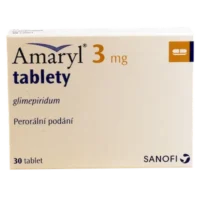Description
Jardins (Empagliflozin) Coated Tablets 10 mg. №30
Composition
Each tablet contains 10 mg of empagliflozin.
Mechanism of Action
Empagliflozin inhibits the sodium-glucose cotransporter 2 (SGLT2) in the kidneys, leading to increased glucose excretion in the urine and improved glycemic control.
Pharmacological Properties
Jardins tablets act as an adjunct to diet and exercise to enhance glycemic control in adults diagnosed with type 2 diabetes mellitus.
Indications for Use
Jardins tablets are indicated for adults with type 2 diabetes mellitus to improve glycemic control when used in conjunction with diet and exercise.
Contraindications
Avoid Jardins tablets if there is a history of serious hypersensitivity reactions to empagliflozin. It is contraindicated for individuals with severe renal impairment.
Side Effects
Common side effects may include urinary tract infections, genital yeast infections, and increased urination.
Usage Instructions
The recommended dosage is one 10 mg tablet per day. Take the tablet orally with or without food as directed by your healthcare provider. Follow the instructions provided for optimal results and do not exceed the recommended dosage.
Benefits Compared to Analogues
Clinical studies have shown that empagliflozin significantly reduces the risk of cardiovascular events and mortality in patients with type 2 diabetes. Research published in the New England Journal of Medicine demonstrated the cardiovascular benefits of empagliflozin, indicating its role in reducing the risk of heart failure hospitalization and cardiovascular death compared to a placebo.
Suitable Patient Groups
Jardins tablets are suitable for adult patients with type 2 diabetes mellitus who require improved glycemic control. Consult your healthcare provider for guidance on specific patient groups such as children or the elderly.
Storage and Shelf Life
- Storage: Keep Jardins tablets at room temperature away from moisture and heat.
- Shelf Life: Check the packaging for the expiration date and do not use the product after this date.
Packaging Description
Jardins tablets are packaged in a container with 30 coated tablets, each containing 10 mg of empagliflozin.





